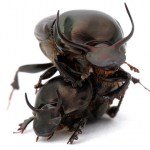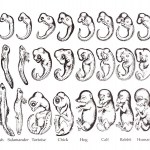development
No, not really — my title is a bit of a sensationalistic exploitation of the thesis of a paper by Peterson, Dietrich, and McPeek, but I can buy into their idea that microRNAs (miRNAs) may have contributed to the pattern of metazoan phylogenies we see now. It's actually a thought-provoking concept, especially to someone who favors the evo-devo view of animal evolution. And actually, the question it answers is why we haven't had thousands of Cambrian explosions.
In case you haven't been keeping up, miRNAs are a hot topic in molecular genetics: they are short (21-23 nucleotides) pieces of…
The turtle's shell provides it with a formidable defence and one that is unique in the animal world. No other animal has a structure quite like it, and the bizarre nature of the turtle's anatomy also applies to the skeleton and muscles lying inside its bony armour.
The shell itself is made from broadened and flattened ribs, fused to parts of the turtle's backbone (so that unlike in cartoons, you couldn't pull a turtle out of its shell). The shoulder blades sit underneath this bony case, effectively lying within the turtle's ribcage. In all other back-boned animals, whose shoulder blades sit…
Chalfie is interested in sensory mechanotransduction—how are mechanical deformations of cells converted into chemical and electrical signals. Examples are touch, hearing, balance, and proprioception, and (hooray!) he references development: sidedness in mammals is defined by mechanical forces in early development. He studies this problem in C. elegans, in which 6 of 302 nerve cells detect touch. It's easy to screen for mutants in touch pathways just by tickling animals and seeing if they move away. They've identified various genes, in particular a protein that's involved in transducing touch…
Answers in Genesis has evolutionary biology on the run now. In an article from 2002, Ostrich eggs break dino-to-bird theory, they explain that development shows that evolution is all wrong, since developmental pathways in different animals are completely different, and can't possibly be the result of gradual transformations.
The first piece of evidence against evolution is the old avian digit problem. Birds couldn't have evolved from dinosaurs, because they have the wrong finger order!
The research conclusively showed that only digits two, three and four (corresponding to our index, middle…
I've been reading a new book by Jack Horner and James Gorman, How to Build a Dinosaur: Extinction Doesn't Have to Be Forever(amzn/b&n/abe/pwll), and I was pleasantly surprised. It's a book that gives a taste of the joys of geology and paleontology, talks at some length about a recent scientific controversy, acknowledges the importance of evo-devo, and will easily tap into the vast mad scientist market.
It is a little scattered, in that it seems to be the loosely assembled concatenation of a couple of books, but that's part of the appeal; read the chapters like you would a collection of…
There are several papers and letters in Nature Genetics on the relationship between menarche, menopause, etc. and genetics.
Meta-analysis of genome-wide association data identifies two loci influencing age at menarche:
We conducted a meta-analysis of genome-wide association data to detect genes influencing age at menarche in 17,510 women. The strongest signal was at 9q31.2 (P = 1.7 10-9), where the nearest genes include TMEM38B, FKTN, FSD1L, TAL2 and ZNF462. The next best signal was near the LIN28B gene (rs7759938; P = 7.0 10-9), which also influences adult height. We provide the first…
I've been doing it wrong. I was looking over creationist responses to my arguments that Haeckel's embryos are being misused by the ID cretins, and I realized something: they don't give a damn about Haeckel. They don't know a thing about the history of embryology. They are utterly ignorant of modern developmental biology. Let me reduce it down for you, showing you the logic of science and creationism in the order they developed.
Here's how the scientific and creationist thought about the embryological evidence evolves:
Scientific thinking
An observation: vertebrate embryos show striking…
...these would be the beetles of choice.
Onthophagus taurus dung beetles,
showing size and horn variation among males.
Dung beetles in the widespread genus Onthophagus sport a bewildering array of horns. Not only do the horns of different species vary in shape, size, and the body part from which they grow, many species show a marked dimorphism within the males.
Consider these two male morphs of O. nigriventris, an African species:
The big guy on the right is a major male, and he does pretty much what you'd expect. He bullies his way around with shows of bravado, guarding his burrows…
My first column in the Guardian science blog will be coming out soon, and it's about a recent discovery that I found very exciting…but that some people may find strange and uninteresting. It's all about the identification of nodal in snails.
Why should we care? Well, nodal is a rather important — it's a gene involved in the specification of left/right asymmetry in us chordates. You're internally asymmetric in some important ways, with, for instance, a heart that is larger on the left than on the right. This is essential for robust physiological function — you'd be dead if you were…
God blessed a Chinese woman with twin baby boys, each one ensouled at the instant of fertilization with personhood and a personal divine fate. At their birth, though, the doctors callously ended one proud male life…and they've probably got the poor fellow pickled in a jar somewhere. Here's a photo of the pair.
That is a baby. The odd blob on his back? That's his brother, a nicely formed penis growing and thriving there. This is a case of fetus in fetu, in which a mass of cells, either an absorbed twin or a large teratoma (a surprisingly well differentiated, but abnormal, fragment of…
Be it in sports or comedy, they say that timing is everything. In evolution, it's no different. Many of the innovations that have separated us from other apes may have arisen not through creating new genetic material, but by subtly shifting how the existing lot is used.
Take our brains, for example. In the brains of humans, chimps and many other mammals, the genes that are switched on in the brain change dramatically in the first few years of life. But Mehmet Somel from the Max Planck Institute for Evolutionary Anthropology has found that a small but select squad of genes, involved in the…
A while back, I got a letter from a student at the University of Texas named Mark, who had been confronted by a group of those typically hysterical anti-choice people on campus. They made an assertion I've heard many times, and he asked me to counter it.
So there I was, walking along the University of Texas campus, enjoying an absolutely gorgeous day (it was 75 and sunny!) when all of a sudden I'm accosted by a huge structure covered with gigantic (10+ ft) pictures of 5-20 week old fetuses. Surprise! I'd forgotten all about our annual day of political theatre hosted by some pro-life group on…
From the first dawn of life, all organic beings are found to resemble each other in descending degrees, so that they can be classed in groups under groups.
Isn't that a good sentence? It's the first of this chapter. There's music in the way the Biblical ring of "From the first dawn of life", falls towards the swallowed repetition of "groups under groups", which itself mirrors and explains the descending degrees of resemblance that gives the sentence its scientific filling.
The next line is just as good: "This classification is evidently not arbitrary like the grouping of the stars in…
Jonathan Wells recently gave a talk in Albuquerque at something called the "Forum on Science, Origins, and Design", a conference about which I can find absolutely nothing on the web. I wasn't there, of course, and I don't get invited to these goofy events anyway, but I did get a copy of Wells' powerpoint presentation from an attendee. It's titled "DNA Does Not Control Embryo Development" — shall we look at it together? It's really a hoot.
Jonathan Wells has been exposed to a little bit of knowledge, just enough for him to regurgitate a few common phrases that are current in the developmental…
Usually, Begley is reasonably good on science, but her latest piece is one big collection of misconceptions. It reflects a poor understanding of the science and of history, in that it confuses long-standing recognition of the importance of environmental factors in gene expression with a sudden reinstatement of Lamarckian inheritance, and it simply isn't — she's missed the point of the science and she has caricatured Lamarck.
Some water fleas sport a spiny helmet that deters predators; others, with identical DNA sequences, have bare heads. What differs between the two is not their genes but…
Minnesota Atheists' "Atheists Talk" radio show.
Sunday, December 28, 2008, 9-10 a.m. Central Time
Exploring Your Inner Zebrafish
Listen this Sunday to Geneticist Dr. Perry Hackett and Evo Devo Biologist PZ Myers as they discuss the Top Life Science Stories of 2008.
Big genome stories were everywhere in 2008. The cancer genome, the woolly mammoth genome, the synthetic genome revealed their secrets. Inexpensive genetic tests hit the market and new data on understanding human ancestry. Biologists also made headlines with high speed sequencing, pluripotent stem cells, RNA regulation, copy number…
We have a long history in developmental biology of studying the most amazing freaks of nature — damage to developing organisms can produce astonishingly ghastly results as the embryo tries to regulate and recover, yielding results that are almost normal. There's even a whole subdiscipline of the field, teratology, dedicated to studying aberrations of embryology. The word is perfect, since it is derived from a Greek root that means both "wonders" and "monsters".
An unfortunate child in Colorado was the recipient of one of these wonders/monsters. Diagnosed with a brain tumor, when surgeons…
Simon Ings has written a wonderful survey of the eye, called A Natural History of Seeing: The Art and Science of Vision(amzn/b&n/abe/pwll), and it's another of those books you ought to be sticking on your Christmas lists right now. The title give you an idea of its content. It's a "natural history", so don't expect some dry exposition on deep details, but instead look forward to a light and readable exploration of the many facets of vision.
There is a discussion of the evolution of eyes, of course, but the topics are wide-ranging — Ings covers optics, chemistry, physiology, optical…
This is a spectacular video of the development of Clypeaster subdepressus, also called a sand dollar or sea biscuit. These are stunningly beautiful creatures (as are we all, of course), and it is so cool to see them changing here. The video starts with a little echinoderm porn — these animals are profligate with their gametes — and then we see early divisions, gastrulation, the formation of the pluteus larva, metamorphosis into Aristotle's lantern (one of the more charming names for a developmental stage), and into an ungainly spiky juvenile.
This is why some of us are developmental…
Surely there can't be anything objectionable to the Religious Right in a documentary called Animals in the Womb, can there? It sounds like it could be fun, with videos shot using tiny little cameras (and some simulations) of developing embryos in vivo. The only thing I object to is the silly title, since they do have invertebrates and non-mammalian vertebrates on the show, so "womb" is a major misnomer.
It's going to be on Channel 4 in the UK — I suppose I'll have to wait for it to be released on DVD.

